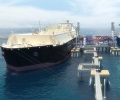
Russia’s seaborne exports of oil products will fall nearly 10% in 2024 after Ukrainian drone attacks damaged major refineries and as higher financing costs and a government ban on gasoline exports added to pressure from Western sanctions, industry sources said.
Russia, one of the world’s biggest oil and fuel exporters alongside Saudi Arabia and the United States, has been trying to access new markets in Asia and South America since the West imposed sanctions over Moscow’s military action against Ukraine in 2022.
Lower fuel exports mean Russian oil companies must increase crude exports to maintain earnings, but those options are limited to India, China and Turkey, which still buy Russian crude despite sanctions and have large refineries of their own.
Russia’s total exports of all fuels including jet fuel oil, diesel, naphtha and kerosene reached 113.7 million metric tons last year, down 9.1% from 2023, two market sources told Reuters, citing export data.
Export figures in 2024 will amount to around 2.3 million barrels per day using a crude oil conversion ratio per ton per barrel of 7.33. The exact breakdown of products – all of which use different conversion rates – is unknown.
Russia’s overall oil processing will fall to about 267 million metric tons (5.4 million barrels per day) in 2024, the lowest level since 2012, due to unplanned shutdowns and weaker refining margins, Reuters calculations based on data from market sources show.
DRONE ATTACK
Ukraine attacked several Russian refineries and fuel facilities, including Lukoil’s refinery in Volgograd, Gazprom Neft’s Omsk oil refinery in western Siberia, the Slavyansk and Novoshakhtinsk refineries, and Rosneft’s Black Sea oil refinery in Tuapse.
Oil refineries are also under pressure due to falling fuel prices, rising interest rates and a ban on gasoline exports by Russia, market sources said.
Total exports of oil products through the Baltic ports of Primorsk, Vysotsk, St. Petersburg Petersburg and Ust-Luga fell 9% in 2024 from a year earlier to 61.96 million tonnes, the data showed.
Fuel exports through Russia’s Black Sea and Azov Sea ports fell to 42.75 million tons, down 10% from 2023.
Exports through Russia’s Black Sea port of Tuapse fell by a third to 9.1 million tonnes due to power outages caused by drone strikes, processing halts and a reduction in refining at a Rosneft refinery, market sources told Reuters.
Meanwhile, exports via the Black Sea port of Novorossiisk rose 4% to 19 million tonnes, the data showed.
Oil product export supplies from the Russian Arctic ports of Murmansk and Arkhangelsk fell to 1.01 million tons, down 14%, while fuel export loads at Far Eastern ports fell 3% from 2023 to 7.97 million tons.
Russia’s seaborne exports of oil products rose 10.8% month-on-month in December to 10.37 million tonnes, including 4.17 million tonnes loaded via Russia’s Black Sea and Azov Sea ports, 5.49 million tonnes via Baltic Sea ports , and 637,100 tonnes via Russian Far Eastern ports, data from Reuters sources and calculations showed.
Source: Reuters




